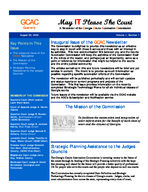GCAC
Quarterly
May IT Please The Court
A Newsletter of the Georgia Courts Automation Commission
August 29, 2006
Volume 1, Number 1
Key Points In This Issue
The inaugural issue of the GCAC Newsletter
The Mission of the Commission
Strategic Planning Assistance to the Judges Councils
Inaugural Issue of the GCAC Newsletter
The Commission is delighted to provide this newsletter as an effective way to stay in touch with those it serves and those with an interest in its activities. This new communication link between you and the Courts Automation Commission will keep the activities of the Commission fresh in the minds of the reader, and perhaps just an importantly, serve as a point of reference for information that might be helpful to the courts and the entire judicial community.
The articles contained in this and future newsletters will be brief and yet concise in content. The intent is to provide as much information as possible regarding specific automation efforts of the Commission.
The newsletter will be published periodically and will contain updates and status reports on current programs and projects of the Commission. This first issue provides information on the recently completed Strategic Technology Plans for all six individual classes of Georgia courts.
MEMBERS OF THE COMMISSION
Supreme Court Chief Justice Leah Ward Sears
Court of Appeals Judge A. Harris Adams
Future issues of this newsletter will be available via the GCAC website and the AOC's Subscription and Notification service.
The Mission of the Commission
Superior Court Judge R. Rucker Smith, Southwestern Circuit (GCAC Secretary)
Superior Court Judge N. Jackson Harris, Blue Ridge Circuit
To facilitate the automation and integration of court information for the benefit of each class of court and the citizens of Georgia.
Superior Court Judge Samuel D. Ozburn, Alcovy Circuit
Juvenile Court Judge Timothy A. Pape, Rome Circuit (GCAC Chair)
Probate Court Judge Kenneth Van Horn, Chattahoochee County, (GCAC Vice Chair)
Magistrate Court Judge Jerry Day, Walker County
Municipal Court Judge A. David Strickland, Covington and Porterdale
Strategic Planning Assistance to the Judges Councils
The Georgia Courts Automation Commission is investing money in the future of the courts through its funding of the Strategic Planning initiatives with the hope that planning well ahead for the future will provide a better quality of professional life for people who serve the courts and the people who depend on well run courts.
The Commission has recently completed Data Definition and Strategic Technology Planning for the six classes of Georgia courts. Judges, clerks, and court administrators from across the state, representing every class of court,
volunteered their time and contributed from their wealth of talents to guarantee the success of these efforts.
The Data Definition sessions saw the creation of standard data definitions and information flow charts for the courts. The Strategic Technology Planning sessions saw the development of technology plans for each class of court.
Pictured above is a work group session of the Council of State Court Judges
"It's better to be prepared for an opportunity and not have one than to have an opportunity and not be prepared."
Whitney, Young Jr.
Next Meeting of the Commission: December 6, 2006 9:00 am till 12:00 noon Wyndham Vinings Hotel Atlanta, GA.
Contact Us: On the Web at: http://gcacommisssion.org By e-mail at: GCAC@gcacommission.com
As one of its FY05 and FY06
Strategic Objectives the Commission agreed to assist all six classes of Georgia courts with the development of Individual Strategic Technology Plans. These plans are now completed and in the hands of the Councils of Judges and volunteers from the courts who attended the work sessions facilitated by GCAC. Both the Data Definition and Strategic Technology documents are available from the Commission's web site
http://www.gcacommission.org.
The Data Definitions exercise helped
identify the mandatory data elements used by the courts and mapped their importance to other stakeholders. The next steps for GCAC in this process will be the mapping of these data elements to an adopted standard to help ease the "translation" between disparate systems and across the levels of courts. An additional and equally important goal of this process will be to minimize or even eliminate the need to impact existing software through this translation.
These reports represent the
proactive, forwarding thinking action of dedicated Councils willing to take the lead and plan the future of their own courts. A majority of the information captured for these documents would not have been possible without the dedication of the volunteers from each level of court representing each Council, giving unselfishly of their time and talents to make it so.
The work in the Data Definition Sessions began at the grass roots level of defining a majority of the data elements required to support the day-to-day efforts of the Courts, and escalated to the extremely high level of planning the anticipated technology for the courts in the coming years. The follow-on to this effort will require the leadership of the Councils to advance the momentum begun in those sessions. The Commission is ready to support the Councils in this effort.
Each Council will share their reports with their peers and other stakeholders and use them to continue to build the foundation needed to support their individual Information Technology and automation needs of their courts.
New thoughts and ideas will surface
from the sharing of these documents, resulting in additional guidance and direction for GCAC as it broadens its support for each Council's success in achieving their strategic goals.
The plans are in place and the
implementation can now begin. Each plan includes clearly defined objectives, initiatives, and next steps to aide the Councils with launching their individual actions to drive the implementation. The focus for the Commission is now on the coordination with the Judges' Councils to participate and lead the development of a judiciary-wide IT Strategic Plan.
2
